Type Deep Tube, sub surface Stations 27 Website tfl.gov.uk | Colour on map Silver | |
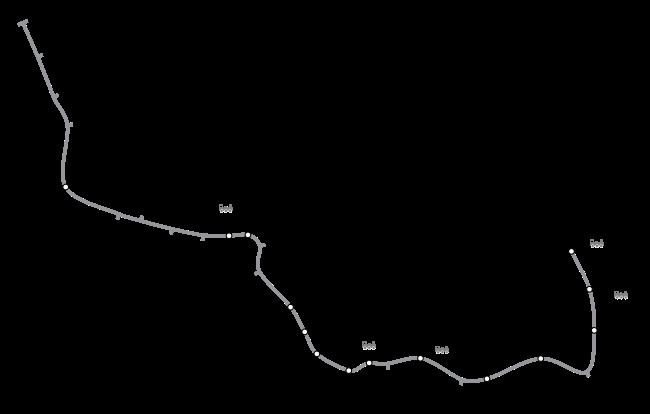 | ||
Ridership 213.554 million (2011/12) passenger journeys Similar Victoria line, Piccadilly line, Bakerloo line | ||
London underground jubilee line train leaving bond street
The Jubilee line is a London Underground line. Opened in 1979, it is the newest line on the network, although some sections of track date back to 1932 and some stations to 1879. Its western end beyond Baker Street was previously the Stanmore branch of the Bakerloo line, while the new build was completed in two major sections: initially in 1979 to Charing Cross tube station in central London; then extended in 1999 with the Jubilee Line Extension to Stratford station in east London. The later stations are larger and have special safety features, both aspects being attempts to future-proof the line. Following the extension into east London, serving areas once poorly connected to the Underground, the line has seen a huge growth in passenger numbers and is currently the third busiest on the network, with over 213 million passengers per year. The Jubilee line is coloured silver/grey on the Tube map, to mark the Silver Jubilee of Elizabeth II after which the line was named.
Contents
- London underground jubilee line train leaving bond street
- 1932 to 1939
- 1939 to 1979 the Fleet line
- Proposed extensions
- Actual extension
- Current Jubilee line
- Station features
- Rolling stock
- 7th car upgrade
- Signalling system
- Service frequency
- 24 hour weekend service
- Thamesmead branch
- West Hampstead interchange
- Services
- Former stations
- Depots
- Gallery
- References
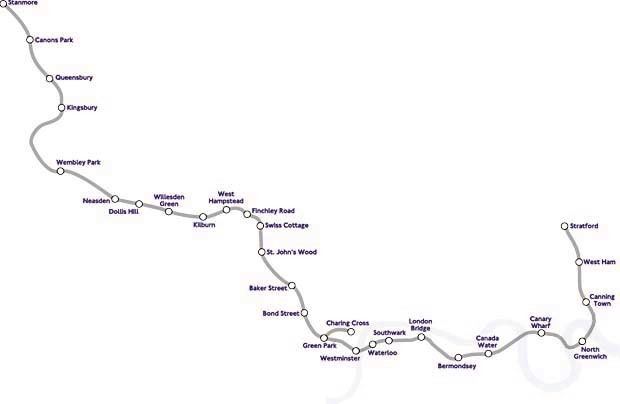
Between Finchley Road and Wembley Park, the Jubilee line shares its route with the Metropolitan line and Chiltern Main Line. Between Canning Town and Stratford, the line runs parallel to the Stratford International branch of the Docklands Light Railway.
1932 to 1939
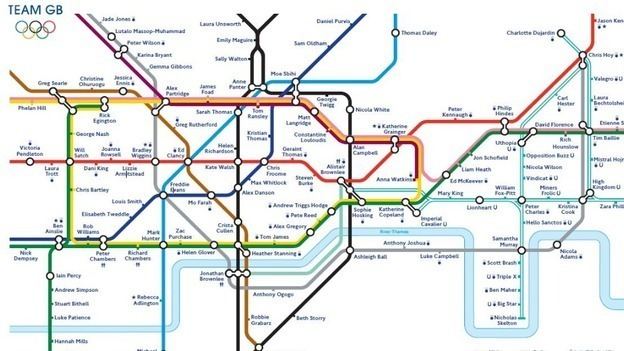
In 1932, the Metropolitan Railway built a branch from its main line at Wembley Park to Stanmore. The line, as with many others in the northwest London area, was designed to absorb commuter traffic from the new and rapidly expanding suburbs. The line presented the Metropolitan with a problem – so successful was the suburban traffic that, by the early 1930s, the lines into Baker Street were becoming overloaded, a problem which was exacerbated by the post-war flight from the City of London to the West End of London.
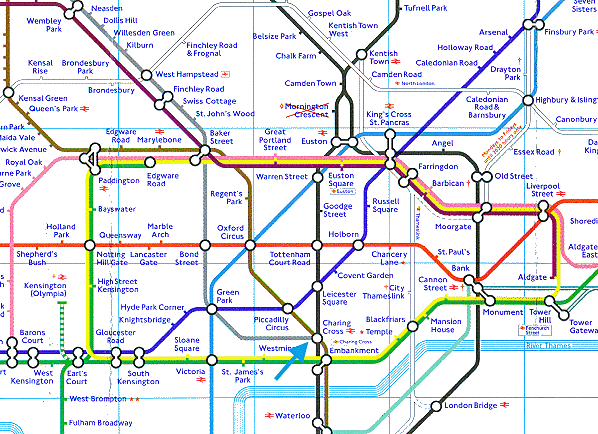
At first, the Metropolitan had advocated a new underground line roughly following the line of the Edgware Road between the tube station and a point near Willesden Green. Indeed, construction advanced as far as the rebuilding of Edgware Road station to accommodate 4 platforms of 8-car length. Things changed, though, with the formation of the London Passenger Transport Board (LPTB) and the subsequent absorption of the Metropolitan. The solution was now a new branch of the Bakerloo line from Baker Street to serve new stations at St. John's Wood and Swiss Cottage, thereby rendering the existing stations of Lord's, Marlborough Road and Swiss Cottage on the parallel route redundant, and negating the need for the Met's extension from Edgware Road station. It was originally proposed that Swiss Cottage (Metropolitan) would remain open during peak hours for interchange with the Bakerloo, and that Lord's station would open for special cricketing events, but both were closed permanently as economy measures during the Second World War. The new line rose between the Metropolitan tracks at Finchley Road, providing cross-platform interchange with the Metropolitan line. Continuing north to Wembley Park, the new Bakerloo was to provide intermediate service on the Metropolitan line, allowing Metropolitan line trains to run non-stop between Finchley Road and Wembley Park, cutting seven minutes from journey times. At Wembley Park, the new Bakerloo would run on to serve Kingsbury, Queensbury, Canons Park and Stanmore, taking over the former Metropolitan branch. The Bakerloo extension, built as above, opened in 1939.
1939 to 1979, the Fleet line
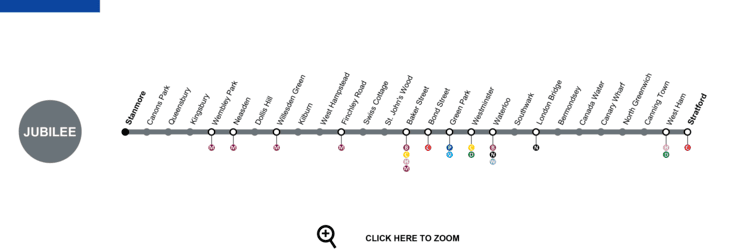
The planning for the Tube network immediately before and after World War II considered several new routes. The main results of this study concerned two major routes: the south-to-northeast "line C", and lines 3 and 4, new cross-town routes, linking the northeast suburbs to Fenchurch Street, Wapping and variously Lewisham and Hayes. Line C opened as the Victoria line, in stages, from 1968 to 1972. Work on the northeast–southwest route continued.

The "Fleet line" was mentioned in a 1965 Times article, discussing options after the Victoria line had been completed — suggesting that the Fleet line could take a route via Baker Street, Bond Street, Trafalgar Square, Strand, Fleet Street, Ludgate Circus and Cannon Street, then proceeding into southeast London. The new line was to have been called the Fleet line after the River Fleet (although it would only have crossed under the Fleet at Ludgate Circus; the central London section mostly follows the Tyburn).
In 1971, construction began on the new Fleet line. Economic pressure and doubt over the final destination of the line had led to a staged approach. Under the first stage, the Baker Street-to-Stanmore branch of the Bakerloo line was joined at Baker Street to a new 2.5-mile (4 km) segment into central London, with intermediate stops at Bond Street and Green Park and terminating at a new station at Charing Cross, thereby relieving pressure on the West End section of the Bakerloo line between Baker Street and Charing Cross and also allowing increased frequencies on the section north of Baker Street. The new tube was to offer cross-platform interchange between the Bakerloo and Fleet at Baker Street, as pioneered on the Victoria line. The work was completed in 1979. As part of the works, Trafalgar Square (Bakerloo) and Strand (Northern) stations were combined into a single station complex, Charing Cross. The existing Charing Cross station on the sub-surface District and Circle lines was renamed Embankment.
Another part of the works included a section of test tunnel, built near New Cross. This part of London has waterlogged soil that is difficult to tunnel in, so a new tunnelling method, called the Bentonite shield, was used experimentally to construct a 150m section of tunnel, that was on the line of the proposed route, in 1971. When the planned route was altered, this section was left abandoned as it was effectively useless, and still exists to this day.
In 1975, when plans were under way to introduce the London Transport Silver Jubilee Bus fleet, the then Sales Manager of London Transport Advertising, Geoffrey Holliman, proposed to the Chairman of LTE, Kenneth Robinson, that the Fleet line should be renamed the Jubilee line. However, this idea was rejected because of the additional costs involved. Nevertheless, the project was subsequently renamed the Jubilee line for Queen Elizabeth II's 1977 Silver Jubilee following a pledge made by the Conservatives in the Greater London Council election of 1977. The original choice of battleship grey for the line's colour was based on the naval meaning of the word fleet; this became a lighter grey, representing the silver colour of the Jubilee itself.
The line was officially opened by the Prince of Wales on 30 April 1979, with passenger services operating from 1 May 1979.
Proposed extensions
The Jubilee line of 1979 was to be the first of four phases of the project, but lack of funds meant that no further progress was made until the late 1990s.
An alternative plan was devised in the 1970s to extend the Jubilee line parallel to the River Thames: this would have taken the line from Fenchurch Street to Thamesmead via St Katharine Docks, Wapping, Surrey Docks North, Millwall (near to South Quay DLR station), North Greenwich, Custom House, Silvertown, Woolwich Arsenal, and thence to Thamesmead. The depot would have been at Beckton, roughly on the site of the current Docklands Light Railway depot. However the 'River line', as this extension was called, was deemed too expensive and construction of the extension never proceeded.
Actual extension
Changes in land use, particularly the urban renewal of the Docklands area, resulted in the project to extend the line beyond Charing Cross being changed considerably in the 1970s, 1980s and 1990s. The Jubilee Line Extension, as the eventual project became known, opened in three stages in 1999. It split from the existing line at Green Park, creating a one-station branch to Charing Cross which is now closed (though still maintained for reversing trains at times of disruption, and for occasional use as a film set). The line extends as far as Stratford, with ten intermediate stations. This section is unique on the London Underground because it is the only section to have special platform edge doors which open automatically when trains arrive.
There have been other proposals to extend the line serving the docks.
Current Jubilee line
Having been open since 1979, the Jubilee line is the newest line of the London Underground network. The trains were upgraded in 1997 to the 1996 stock. In 1999, trains began running to Stratford instead of Charing Cross, serving areas once poorly connected to the London Underground network.
Station features
Jubilee line stations north of Baker Street were not built specifically for the Jubilee line. St. John's Wood and Swiss Cottage stations were opened in 1939 on the then-new Bakerloo line branch and have more traditional tube station features. Stations north of Finchley Road were opened by the Metropolitan Railway (now the Metropolitan line), but they became part of the Bakerloo in 1939, with only Wembley Park being shared with the Metropolitan. Then, the Jubilee line took over the whole of the Bakerloo line service between Baker Street and Stanmore. The only 'new' stations built for the original Jubilee line were the Baker Street westbound platform (eastbound opened in 1939), Bond Street, Green Park and the now-closed Charing Cross.
Stations on the Jubilee Line Extension feature:
The platform edge doors were introduced primarily to prevent draughts underground and to assist in air flow. They also prevent people from falling or jumping onto the track, as well as the build-up of litter.
Rolling stock
When the Jubilee line was opened, it was operated by 1972 stock. In 1984 this was partially replaced by the new 1983 stock: the displaced 1972 stock was transferred to the Bakerloo line. The 1983 stock proved to be unreliable and troublesome in service, with single-leaf doors making passenger loading and unloading a slower process than on other stock with wider door openings. With the construction of the Jubilee line Extension, the opportunity was taken to introduce new trains, and today the line is worked by 1996 stock, which has an exterior similar to the 1995 stock in use on the Northern line but (in spite of the confusing naming) is technically less advanced. The new stock has internal displays and automated announcements to provide passengers with information on the train's route. At first the displayed text was static and showed only the destination of the train, but later showed also the name of the next station and interchanges there. Subsequent modifications introduced scrolling text. The 1996 stock uses a different motor from the 1995 stock and has a motor design similar to Class 465 and Class 466 Networker trains.
7th car upgrade
The Jubilee line closed for five days from 26 December 2005 in order to add an extra car to each six-car train. The line had to be closed as six-car and seven-car trains could not run in service at the same time, because the platform-edge doors at Jubilee Line Extension stations could not cater for both train lengths simultaneously. The signalling system was also modified to work with the longer trains.
Previously, an extra four complete 7-car trains had been added to the fleet, bringing the total to 63. This enabled the period during which a full service could be run to be increased. The full fleet will not be required to be available until full advantage is taken of the new signalling system.
The result of the 7th-car upgrade was a 17% increase in capacity, allowing 6,000 more passengers per hour to use the line. Work was completed and the line reopened two days ahead of schedule, on 29 December 2005.
Signalling system
The Jubilee line has been converted to automatic train operation, using the SelTrac S40 moving block system. The new system enables London Underground to run more frequent trains, increase capacity by a further 33%, and cut journey times by around 22%. Equipment installation and testing for the new systems began in late 2006, and the line upgrade work required the closure of sections of the Jubilee line each weekend during 2009. Although the project was due for completion in March 2010, the closures continued through 2010, and the upgrade was not finished until spring 2011. The new signalling system finally came into full operation on 26 June 2011. As a result, services began operating at the new higher frequency of 27 trains per hour from late July 2011, and this should increase to 30 per hour in 2012.
Under automatic operation, the on-train computer instructs the train what to do. The underlying protection and control system is called TBTC, which stands for Transmission-Based Train Control. The computer does everything except opening and closing the doors, starting the train at every station, mending faults and dealing with passengers. If ATO fails but TBTC is still operational, the trains can still be manually driven at line speed under PM (Protected Manual) conditions. Due to the fact that the train receives lots of updates in a short time, it is considered impossible for the driver to drive in this mode in regular service, and the train will be taken out of service and moved off the line as quickly as possible. If TBTC fails on an individual train then it would be put into Restricted Manual mode, which means that the train operator can drive the train at 5–10 mph (8–16 km/h) to the next station, where the train would be taken out of service until the fault is mended by technicians. If the whole TBTC system fails the line can still operate at a top speed of 16 km/h using an auxiliary signal and track circuit system. The signals and track circuits only activate when the TBTC system has failed, and are normally dark.
The system uses two track loops, one to send instructions to the train, and the other to send updates from the train to the control centre. The two loops cross over approximately every 25m, and each 25m section is subdivided into 4 further sections, effectively creating 1600 virtual 'blocks' in every kilometre of track. These loops create mild interference that allows the train to tell when it has passed over one, but not to the extent that the system may be compromised. The system allows trains to get up to 50m away from each other while both are moving at very low speeds, but does not allow bi-directional or "wrong way running". A train has to be put into restricted manual to run the wrong way along a track. There are exceptions, such as the sidings north of Wembley Park and West Hampstead, and a small area around Stratford Market Depot where the track becomes "locked out" to any other train but the one given a movement authority. Trains constantly receive speed instructions based on the train's odometers presumed position, however they receive definite instructions once they report and have passed over a track loop. S40 does not allow speeds higher than 108 km/h, and the 1996 stock had to be upgraded slightly so it could use the new equipment, the most significant of which was a new Vehicle On Board Computer.
The programme of temporary closures for engineering work had been criticised by local politicians as well as by the management of venues such as Wembley Stadium and The O2 because visitors to major concerts and sporting events have had to travel by rail replacement bus. The management of the project by Tube Lines has been criticised by London TravelWatch for its delayed delivery date, and a report by the London Assembly referred to the weekly line closures as "chaotic".
Service frequency
When the Jubilee line was upgraded with a new signalling system allowing Automatic Train Operation on the line, the service frequency increased from 24tph to 30tph for 90 minutes during the peak period. London Underground now plans to increase the frequency to 36tph by 2019, enabling one train every 100 seconds between North Greenwich and West Hampstead, with 27tph in off-peak periods between Willesden Green and Stratford. This will allow the line to handle the additional passengers expected to use the line particularly from the West End, City and Docklands and the Stratford area.
24 hour weekend service
It was planned that from Saturday 12 September 2015, there would be a 24-hour service on Friday and Saturday nights on the entire Jubilee line as part of the new Night Tube service pattern. This was postponed due to an ongoing dispute between Transport for London and rail unions. On 26 August 2016 Sadiq Khan, Mayor of London, announced that the Jubilee line would run the night service from 7 October 2016.
Thamesmead branch
When North Greenwich tube station was opened, it was built to enable a branch extension to be built eastwards to Thamesmead. At present there are no plans to construct this branch route.
West Hampstead interchange
Plans were put forward in 1974 and again in 2004 for a West Hampstead interchange, to connect the three West Hampstead stations in one complex, but plans were put on hold in 2007 owing to uncertainty over the North London Line rail franchise. While no connections in the form of railway infrastructure exist, the three stations at West Hampstead form part of an "out of station" interchange in the Oyster system thus continuing similar (but little-publicised) interchange arrangements in existence since before nationalisation.
Services
Jubilee line services are:
Peak:
Some peak services originate/terminate at West Ham or Neasden
Off-Peak:
Night Tube:
Former stations
The Jubilee line platforms at Charing Cross are still used during service suspensions. For example, - when the service is suspended between Green Park and Stratford, trains will terminate (and passengers alight) at Green Park before going to Charing Cross and using a scissors crossover to reverse back westbound. The platforms are a popular set for films and television because the platforms are contemporary and the trains used are current ones that appear in normal passenger service.
Depots
The Jubilee line is currently served by Stratford Market Depot map 29 between the Stratford and West Ham stations.
Trains can also be stabled in Neasden Depot - sharing it with the Metropolitan line.
Gallery
Additional images are available from the Commission for Architecture and the Built Environment (CABE) case studies for the stations at Canary Wharf, North Greenwich, Southwark, and Stratford.
